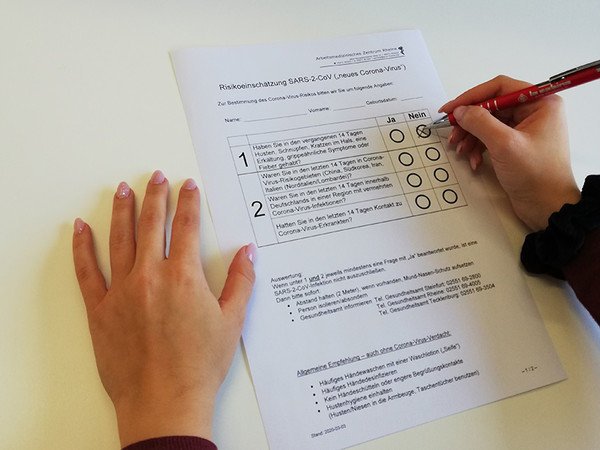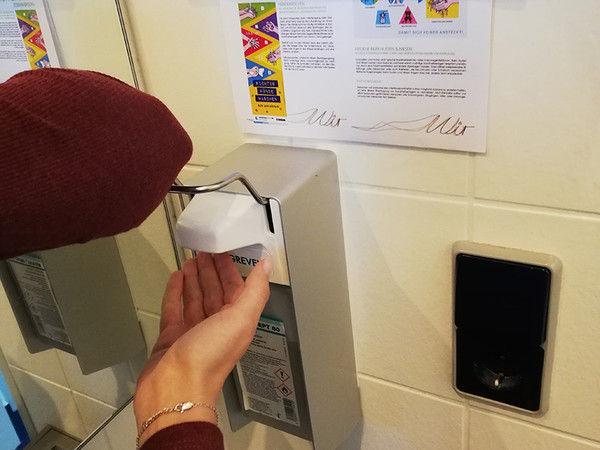Corona in practice: chronology of a crisis
In 2020, an estimated 40 percent of all lifts will need to have a lift emergency call system retrofitted. The GS electronic/GS Group had prepared for this rush. But then came the Corona crisis…
The company was in luck, since lift emergency call and home emergency call systems are produced at the company’s headquarters in Rheine. In addition, the GS Group benefited from the fact that it had engaged in forward-looking advance production and increased storage capacity. In addition, more employees were hired, production capacities increased, and a three-fold quantity of components ordered.
Level I – caution (early March 2020)
A pandemic officer is designated as interface between the Health Office, company employees and management. He maintains a weekly health questionnaire for the workforce, which provides information on the situation.
If two of the four questions included are answered with yes, the employee has to go home, and the Health Office is informed. Journeys to severely affected areas, contact with those who have tested positive for Covid-19 and the person's own health status are surveyed.
This questionnaire is available via the company intranet and forums created for virtual exchanges. In addition, hygiene guidelines and information on the virus are printed out and posted on the notice board. Hygienic articles are provided to an increased extent, reordered and cleaning plans revised to focus on frequent contact surfaces.
All field service activity is now stopped, meetings with guests, already booked courses and a company fete have been cancelled.
Level II – protecting the heart (mid-March 2020)
 A weekly health questionnaire for the workforce provides information on the situation. Photo: © Raphael Gorski/GS electronic
A weekly health questionnaire for the workforce provides information on the situation. Photo: © Raphael Gorski/GS electronicThe situation deteriorates. Workplaces are moved further apart to reduce the mutual risk of infection. Construction projects planned for the summer are brought forward and completed at top speed. As a result, the construction teams create more workplaces to enable employees to be distributed over five locations. Joint breaks are prohibited to protect the employees of the emergency call and service control centre.
All desk sharing workplaces are permanently assigned. Where possible, departments are given their own floors to avoid unnecessary contact. At the same time, personal meetings are replaced as far as possible by teleconferencing.
The IT department acquires a large number of laptops, IP telephones and headsets to prepare mobile workplaces.
Level III – Corona gets closer (mid/late March)
The first employees stay home, IT splits up to be on the safe side. Since kindergartens and schools are closed, childcare becomes the next challenge for parents.
The emergency call/ service control centre is screened off additionally. Employees from outside the emergency call control centre may no longer enter the area. Kitchens are no longer divided; the emergency call control centre may only be entered via a separately assigned area of the buildings. Hygienic installations and toilets are no longer shared with other departments; they are cleaned at shorter intervals.
Contact with the company doctor and Health Office becomes closer; entry permits for the employees of the emergency call control centre as a relevant professional group are handed out as a precaution in the event of curfews.
Lift companies are looking for a solution in the event of quarantine; the demand is sudden and overwhelming. Some partner companies are worried that they can no longer self-manage the emergency call tracking. Within a few days, the number of people liberated from lifts by GS via third parties increases by over 100 percent. The network of liberators developed across Germany now comes to the assistance of the lift companies as buffer.
 Photo: © Raphael Gorski/GS electronic
Photo: © Raphael Gorski/GS electronicLogistic service providers inform us our shipments can only still be delivered once (without additional delivery attempts) and then handed over free of contact.
Level IV: contact prohibition
The plan provides for employees being able to continue to work at home during curfews. Important workplaces, such as emergency call control centres, production and shipping continue to be arranged from the company. Customer service, order processing and customer management are outsourced. The federal government introduces a contact prohibition on 22 March that generously distributes outsourced workplaces.
Britta & Dennis Schönweitz und Raphael Gorski
More information:gselectronic.com
vitakt.com
The GS Group currently includes the affiliated company Vitakt-Hausnotruf GmbH and the jointly used emergency call and service control centres of GS Euro Call Control Center GmbH.
GS Group
• 210 employees
• 350,000 already supervised customers
• 84,000 actively connected emergency call & alarm systems
• daily between 12,500 and 14,500 messages / alarms
• national intervention network via our sales partners
• 5,200 sales partners
• national cooperation with various security service providers





















Write a comment